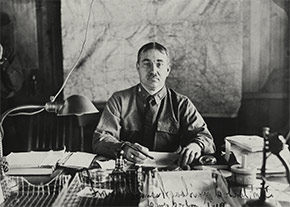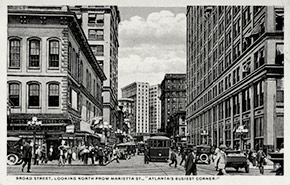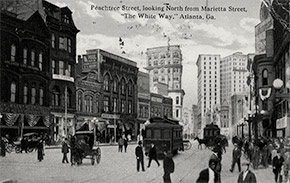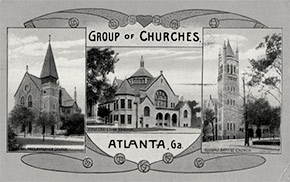Produced by the University of Michigan Center for the History of Medicine and Michigan Publishing, University of Michigan Library
Influenza Encyclopedia
The American Influenza Epidemic of 1918-1919:
A Digital Encyclopedia
Atlanta, Georgia
50 U.S. Cities & Their Stories
On September 18, residents of Atlanta learned that soldiers of the Second Infantry Replacement Regiment at nearby Camp Gordon – just a dozen miles from downtown Atlanta – had been placed under quarantine by the camp commandant after several soldiers fell ill with influenza upon returning from a training session at the nearby Norcross firing range. Two days later, after cases began appearing in other regiments at the camp, Brigadier General W. H. Sage also placed the First, Second, and Fourth Regiments, as well as several smaller units, under quarantine. Sage prohibited these soldiers from entering or using any of the camp halls, amusement venues, or other gathering places, and barred from visiting Atlanta or Chamblee for at least ten days. Altogether, approximately half of the men of the camp were placed under quarantine.1
Atlantans were not caught completely off-guard. They were well aware of the severe epidemics of influenza currently plaguing cities of the Northeast. They were also aware of the way in which the disease spread, and were warned to avoid crowds and crowded places, poorly ventilated buildings, and common drinking cups. The messages were mixed, however. On the one hand, local newspapers reported on United States Surgeon-General Rupert Blue’s survey results, which found that several cities and military camps were in the midst of serious epidemics. On the other hand, the United States Public Health Service told residents that the current form of influenza circulating was “nothing but an aggravated form of the old-fashioned grip,” and was not especially dangerous unless the victim contracted pneumonia. Atlantans were told they had little to fear now that Camp Gordon was under quarantine.2 If only that were true.
For the time being, the disease remained within the confines of the camp. By the first days of October, there were over 1,900 cases reported there. Overwhelmed, medical officers issued an urgent call for 75 trained nurses. Twelve brave women from Atlanta immediately responded. The Red Cross and the Atlanta Registered Nurses’ Club worked to organize more volunteers. Camp Jackson in South Carolina, in the midst of its own devastating epidemic, also requested help from Atlanta nurses, but the need was so great at Camp Gordon that the appeal had to be denied. At the camp, chief surgeon Colonel Frank T. Woodbury, authority on military medical management, ordered increased sanitary measures in barracks, implemented mandatory mask use by all soldiers and officers, and, a few days later, ordered the soldiers to sleep outdoors in the fresh air.3 Ultimately, nearly 2,000 enlisted men were admitted to the camp’s infirmary for influenza and pneumonia during the epidemic, and 94 of them died as a result of the disease.4
In Atlanta, city health officer Dr. J. P. Kennedy was well aware of the situation both at Camp Gordon and all along the east coast. Thus far, there did not appear to be an epidemic in Atlanta; only one death from influenza and three deaths from pneumonia had been reported to Kennedy’s office, although, since influenza was not yet reportable, it was impossible to ascertain with any certainty just how widespread cases may have been. Kennedy realized, however, that the epidemic that was raging in Camp Gordon would likely show up at his city’s doorstep in the coming days, most likely introduced by civilians traveling to Atlanta by train. He warned residents to take precautions against influenza.5 At the same time, the Georgia Board of Health issued a similar warning against influenza, informing residents of the disease’s symptoms and recommending that people avoid crowds and public assemblies.6 Two days later, on October 6, the Atlanta Board of Health made influenza a reportable disease. Kennedy estimated that there were at least several hundred cases already circulating in the city, but assured residents that there was no epidemic yet.7
The City Closes
The next day, United States Surgeon General Rupert Blue notified all state health officers that they should consider enacting social distancing measures to prevent the spread of influenza. In Georgia, health officer Dr. T. F. Abercrombie decided to leave that decision up to local authorities. Kennedy wasted no time in deciding to – as he put it – “lock the stable before the horse was stolen.” Thus far there were only a handful of cases reported and no discernible epidemic. Yet Kennedy believed that there were probably fifteen to twenty active influenza cases per physician in the city. Knowing what had occurred in cities such as Boston, he decided not to wait for a more serious outbreak. At a short afternoon meeting on October 7, Kennedy and the city Board of Health voted to close all schools, libraries, theaters, movie houses, dance halls, churches, and other places of public amusement, and ordered street cars to keep their windows wide open except when raining. Just in case there was any question as to the authority of the Board to issue such an order, the city council followed suit with a resolution to the same effect, closing public places for a period of two months or until the epidemic had passed. Violation of the closure order came with a hefty $200 fine. Whether because of the tone set by the Board of Health and the city council or because of a sense of civic duty, Atlanta’s business interests were models of cooperation. Immediately after the Board of Health’s meeting and just before the first of the day’s matinees were set to begin, managers of the Wells, Lyric, Forsyth, and Rialto theaters canceled their shows and closed their doors. Students reported to their classrooms the next morning only long enough to collect their books and homework assignments. Later that day, Fulton County health officials closed all churches and public and private schools in the county. Atlanta and its environs settled down for a long, entertainment-less autumn. Fortunately, residents could still attend the Southeastern Fair and Liberty Pageant, allowed to proceed because it was held outdoors.8
As physicians began reporting their cases more regularly, Kennedy began to get a sense of his city’s epidemic. Each day brought 100 to 150 new cases to the tallies.9 Although Kennedy insisted that this number of cases did not actually constitute an epidemic, it was clear that influenza was already exacting a toll on Atlanta. Nurses were in such great demand that Kennedy had to refuse a request from nearby Conyers, Georgia. “We have no nurses to spare,” Kennedy commented. Camp Gordon’s epidemic and Atlanta’s own need had siphoned off all available help. Health department welfare nurses, along with Red Cross nurses, busied themselves caring for the city’s ill and providing warm meals for families.1
Even by mid-October Kennedy remained sanguine that influenza would not become epidemic in Atlanta. State health officer T. F. Abercrombie was of a similar mind, believing that influenza had been “checked.”11 Theater owners and managers certainly believed that the epidemic was not severe enough to require them to remain closed. In fact, the initial cooperative spirit had now waned. The Atlanta Theater Managers’ Association (ATMA) protested that they be required to keep their doors closed while the Southeastern Fair be allowed to continue. Theaters in New York, they argued, remained open. Furthermore, they claimed, their theaters were clean, while the fair was rather unsanitary. The ATMA estimated that theaters had lost more than $22,000 thus far as a result of the closures. Each of Atlanta’s nineteen theaters had a weekly payroll of between $175 and $330, pay that was lost to workers each day that the closure order remained in place. To placate the ATMA, Kennedy and Abercrombie announced that they would visit the fair to evaluate its conditions and determine whether or not it should be closed. In the meantime, Abercrombie ordered that all fairgoers would be required to wear masks.12 Fortunately, this did not dampen the mood for the crowds. Band concerts, circus acts, horse races, addresses by the Four-Minute Men, agricultural exhibits and fireworks all played to a sea of half-disguised revelers. On closing night, fair-goers were treated to free outdoor movies produced by the government as part of the Fourth Liberty Loan drive, and they thrilled to appeals by Charlie Chaplin, Lillian Gish, Mary Pickford and more.13
The Pressure to Reopen
There were now over 2,000 cases of influenza reported in Atlanta. Kennedy said that the situation was not worsening, and noted that the city was faring much better than cities in the Northeast.14 Still, he was cautious. After a brief conference with Mayor Asa G. Candler, Kennedy announced that the closure order would likely remain in effect for at least another week. “There are indications that the disease has reached its zenith here,” he told the public. “We will pay a toll in deaths this week, however, and next week as well.” Candler stated that he would ask the city council to rescind the closure order and gathering plan as soon as the Board of Health recommended it.15
The Board was not yet ready, however. On October 24, Kennedy stated that he thought schools should remain closed but that he was in favor of allowing other places to reopen. School officials took the health officer’s advice and voted to keep schools closed until at least November 4. Kennedy anticipated that the Board of Health would accept his recommendation for allowing theaters and other public entertainment venues to reopen. When the Board met the next day, however, it struck down Kennedy’s suggestion. Several Board members argued that the influenza situation was more precarious than official figures would suggest, citing as evidence the dozens of unreported cases they each had seen in their private medical practices in the previous several days. Mayor Candler, eager to reopen his city, jumped at the change to go on the attack. “Do you mean to admit that you have violated an order that you yourself helped to pass?” he asked of one Board member. The Board then considered removing the closure order effective November 2. Oddly, however, Mayor Candler voted against the measure, arguing that the Board had no way of predicting what conditions would be like in a week. He wanted Atlanta reopened immediately. With backing from Candler and several Board members, the resolution failed. Upset at the Board’s decision, the mayor immediately announced a special session of the city council, which decided to overrule the Board of Health and allow Atlanta’s places of public gathering to reopen on October 26.16
The epidemic may have improved enough for theaters to reopen, but unfortunately the same could not be said for the weather or the war situation. Because of the war and the need to keep vital industries running, Atlanta was under power consumption restrictions. Non-essential users had their power curtailed, a situation exacerbated by dry weather that left the Tallulah River – the source of Atlanta’s hydroelectric power – lower than usual. Even with the all-clear from city council for theaters to begin operating again, Captain G. K. Miltenberger of the War Industries Board announced that he would only allow them to open for a maximum of six hours each day. It was better than nothing; Miltenberger had previously stated that the theaters would be kept closed completely, regardless of the city council’s decision.17 Fortunately, on Monday, October 28, Miltenberger relaxed the power curtailment enough to allow theaters to return to their normal operating hours. The Atlanta, Lyric, and Grand Theaters reported high attendance, as did the city’s various movie houses. As one reporter put it, after being closed for several weeks, “It seemed that every theatrical performance and every movie was just a little better than it was before the ban, and everybody was in the best of humor.”18
November arrived and the number of new influenza cases in Atlanta continued to decline. Kennedy cheerfully announced that the epidemic has run its course in Atlanta.19 One newspaper reporter wrote that influenza was no longer an interesting topic of conversation. “There have been enough victims in Atlanta to prevent any of them from having that exclusive feeling,” he wrote, “and yet there have not been enough to make much of a boast in years to come when those now present say reminiscently, ‘Back in 1918 when Spanish influenza was raging….’”20 A government report seemed to bear out these observations. According to the US Census Bureau records, only three American cities – Grand Rapids, Cambridge, and Spokane – had lower death rates for the previous week. Atlanta’s death rate was the lowest in the South. By the end of November, the Census Bureau reported that Atlanta’s was still amongst the mildest in the country.21
By Thanksgiving, Atlanta’s influenza cases began to surge once again. Kennedy reassured residents that the increase in cases did not indicate a recurrence of the epidemic. At least one physician complained that most of these supposed cases were actually bad colds, but that people assumed they had influenza and thus called him in order to confirm it. He believed that people simply needed to keep their windows open in order to avoid influenza. Nevertheless, school officials decided to take no chances. Acting School Superintendent Charles Culver announced that any child exhibiting symptoms of a cold would be immediately excluded from school.22
As Christmas approached, Atlanta found itself in growing need to nurses and aides to care for the many ill. The Central Council of Social Agencies, the local chapter of the American Red Cross, the Anti-Tuberculosis Society, and the Associated Charities met to coordinate relief work and to issue calls for volunteers. A central office was formed at the Red Cross headquarters, which served to route calls for help in order to reduce the likelihood of several nurses being dispatched to the same household. The Red Cross also embarked on a citywide survey to ensure that all residents were receiving the care they required and to better allocate nurses and physicians.23 Especially hard-hit was East Atlanta, a section of town only recently incorporated into Atlanta and thus without the same infrastructure and municipal aid that the rest of the city received.24 Still, neither Kennedy nor the Public Safety Committee believed the epidemic severe enough to take further action. “The influenza situation in Atlanta is up to the people themselves,” the Committee declared. In the opinion of Kennedy, closing public places again would be “useless.”25
Kennedy maintained this position throughout the rest of the winter, even as the epidemic grew in strength. By the end of January 1919, the situation had grown severe enough that the Fulton County Medical Society invited members of the state, county, and local health boards as well as military medical officers to confer about what could be done to bring epidemic to an end once and for all. A greater proportion of influenza cases were developing pneumonia than had been the case in the last days of 1918, resulting in an increased number of deaths. An estimated six to eight patients were dying in the hospitals each day. Nurses were severely overworked as they tried to handle the caseloads.26 In the end, however, the conferees decided the best course of action was to isolate cases, quarantine households, and to impress upon the public the need to practice proper cough etiquette and to avoid crowds. The committee also suggested that serious cases of influenza and pneumonia not be transferred to hospitals so that they not infect other patients.27 It is unlikely that Kennedy, the Board of Health, or the City Council would have taken any stronger action in any event.
Conclusion
Atlanta’s death rate remained elevated throughout the rest of February. It was not until mid-March that Kennedy could report that the city’s death rate appeared to be returning to normal and that Atlanta’s second wave of influenza had ended.28
Atlanta closed its public gathering places for just over two weeks total, a rather short period in comparison to many other American cities that issued closure orders. This may have been offset somewhat, however, by the fact that Atlanta was under strict power consumption restrictions in the fall of 1918. Under Captain Miltenberger, all elevators were closed, rolling blackouts kept the city dark two nights a week, and stores were required to close by 6:00 pm on Saturdays. These wartime measures undoubtedly led to an increase in social distancing, and may have had an impact on the shape of Atlanta’s epidemic curve. On the other hand, the number of streetcars in service was significantly reduced in order to save power. This may have encouraged people to walk or take alternate transportation, thus keeping them off of crowded streetcars. It may have contributed to additional crowding, however, as residents waited and jockeyed for a place on fewer cars.
According to the figures reported to the Census Bureau, Atlanta lost a total of 829 residents to the epidemic through the end of February 1919. With a population of just over 200,000, that equates to an epidemic death rate of approximately 414 per 100,000 people. The average for cities in the South and Midwest combined was 413 per 100,000, landing Atlanta right in the middle of these cities.
It is difficult to ascertain just how severe or mild Atlanta’s epidemic was, however. Case reporting in the early days of the epidemic was sporadic, and it appears that many physicians – including two members of the Board of Health – did not submit regular case reports to Kennedy’s office. Because of the requirement to issue death certificates, mortality data is usually more reliable. Kennedy frequently cited US Census Bureau statistics to bolster his claim that Atlanta’s epidemic was one of the mildest in the nation. Examining these records, however, indicates a significant gap in reporting influenza deaths. Atlanta reported influenza deaths to the US Census Bureau for only three weeks during the epidemic (the weeks ending October 12, October 19, October 26). For the rest of the epidemic period, the city reported only pneumonia deaths. It is possible that Atlanta physicians automatically attributed all influenza-related deaths to pneumonia, or that Kennedy did so before forwarding this data to the Census Bureau. It is equally possible, however, that Atlanta only reported pneumonia deaths and omitted those caused by influenza. We simply do not know.
Notes
1 “Quarantine at Camp for Spanish Influenza,” Atlanta Constitution, 18 Sept. 1918, 6; “Will Check Spread of Influenza at Gordon,” Atlanta Journal, 20 Sept. 1918, 4. At the time, Camp Gordon was located in Chamblee, Georgia. In the 1940s, the camp – named Fort Gordon – relocated to Richmond County, outside of Augusta.
2 “Precautions Must be Taken Against Spanish Influenza,” Atlanta Journal, 14 Sept. 1918, 2; “No Danger of Epidemic of ‘Spanish Flu’ Here,” Atlanta Constitution, 22 Sept. 1918, 8.
3 “Atlanta Nurses Respond to Call: More are Needed,” Atlanta Constitution, 3 Oct. 1918, 4; “Roofless Nights’ For Camp Gordon Soldiers,” Atlanta Journal, 7 Oct., 1918, 2. Earlier in 1918, Woodbury had published his Manual for Medical Officers, Being a Guide to the Duties of Army Medical Officers (Menasha, WI: George Banta Publishing, 1918).
4 Maj. Gen. Merritte W. Ireland, ed., The Medical Department of the United States Army in the World War, Volume XV: Statistics, Part Two – Medical and Casualty Statistics (Washington, DC: Government Printing Office, 1925), 967, 983, 997, 1009.
5 “Orie Death Here from Influenza; Rate is Low,” Atlanta Journal, 4 Oct. 1918, 22.
6 “State Health Board Issues ‘Flu’ Warning,” Atlanta Constitution, 4 Oct. 1918, 6.
7 “Physicians Must Report all Cases of Influenza,” Atlanta Journal, 6 Oct. 1918, 5.
8 “Schools and Theaters Closed Because of Flu; Public Gatherings of all Kinds are Banned by Board,” Atlanta Journal, 7 Oct. 1918, 1; “Public Gathering Places Closed by City Council for Two Months,” Atlanta Constitution, 8 Oct. 1918, 1; “’Flu’ Situation Better Tuesday,” Atlanta Constitution, 9 Oct. 1918, 6.
9 Atlanta Journal, “105 New Cases Of Influenza Here, Total Over 400,”Atlanta Journal, 10 Oct. 1918, 5; “Little Change In Influenza Status Reported Locally,” Atlanta Journal, 11 Oct. 1918, 4.
10 Atlanta Constitution, “Welfare workers busy in Atlanta,” Atlanta Constitution, 12 Oct. 1918, 9.
11 “Influenza Situation Shows Little Change,” Atlanta Constitution, 13 Oct. 1918, 13; “State Health Chief Says ‘Flu’ Checked,” Atlanta Constitution, 13 Oct. 1918, B2.
12 “Protest is Made by Theater Men,” Atlanta Constitution, 15 Oct. 1918, 1.
13 “Disguised With Flu Masks Fair Patrons Flock To Big Show,” Atlanta Journal, 16 Oct. 1918, 1; “Great Movie Stars to be Seen Tonight Despite the ‘Flu,’” Atlanta Constitution, 19 Oct. 1918, 1.
14 “Ask Gov. Dorsey to Close Fairs to Check Influenza,” Atlanta Journal, 16 Oct. 1918, 21; “’Flu’ Situation about the Same,” Atlanta Constitution, 18 Oct. 1918, 5.
15 “Reports on ‘Flu’ in State Received,” Atlanta Constitution 19 Oct. 1918, 3.
16 “Flu Ban will Stay, Resolution to Lift It is Voted Down,” Atlanta Journal, 25 Oct. 1918, 1; “Churches to Hold Regular Services Indoors on Sunday,” Atlanta Constitution, 27 Oct. 1918, 4.
17 “Theaters Remain Closed Even if Flu Ban’s Lifted,” Atlanta Journal, 23 Oct. 1918, 1; “Rain Helped Matters Some But Not Enough,” Atlanta Journal, 25 Oct. 1918, 15; “Theaters open Today; To Run 6 Hours Daily,” Atlanta Journal, 26 Oct. 1918, 1.
18 “Lovers of Theaters Happy When Houses Open Again Monday,” Atlanta Constitution, 29 Oct. 1918, 12.
19 “’Flu’ Epidemic Seems to Be Thing of the Past,” Atlanta Journal, 2 Nov. 1918, 10.
20 “Influenza Dwindles to Vanishing Point in Local Interest,” Atlanta Constitution, 3 Nov. 1918, 12.
21 “Atlanta Death Rate Lowest in the South,” Atlanta Constitution, 9 Nov. 1918, 12; “Atlanta Death Rate Next to the Lowest in Dixie for Week,” Atlanta Constitution, 30 Nov. 1918, 3.
22 “Keep Windows Open to Avoid the ‘Flu’ Urges Local Doctor,” Atlanta Constitution, 24 Nov. 1918, B11; “No New Flu Epidemic is Threatened Here,” Atlanta Journal, 24 Nov. 1918, I4.
23 “Red Cross to Aid in Fight on ‘Flu,’” Atlanta Constitution, 17 Dec. 1918, 2; “Will Co-ordinate Anti-Flu Fight,” Atlanta Constitution, 21 Dec. 1918, 7; “Atlanta Red Cross to Furnish ‘Flu’ Patients with Doctors and Nurses,” Atlanta Journal, 17 Dec. 1918, 18.
24 “East Atlanta Hard Hit by Spanish ‘Flu,’” Atlanta Constitution, 14 Dec. 1918, 2.
25 “’Flu’ Precautions Up to Individuals, Committee Decides,” Atlanta Journal, 16 Dec. 1918, 1.
26 “Plan to Prevent Spread of ‘Flu,’” Atlanta Constitution, 26 Jan. 1918, 1.
27 “Steps Outlined for Prevention of ‘Flu’ Spread,” Atlanta Constitution, 29 Jan. 1919, 9.
28 “Atlanta Death Rate Approaching Normal, Says City Physician,” Atlanta Constitution, 12 March 1919, 8; “Local Death Rate 15.5, Influenza Wiped Out,” Atlanta Journal, 13 March 1919, 13.











